
W ovvero “Veronesi e Veronesità”, una serie di cache dedicata a personaggi, luoghi e tradizioni più o meno noti che si propone di farli conoscere o riscoprire attraverso un “Geo-itinerario” il quale, non so ancora bene dove mi/ci porterà, ma vuole essere una dichiarazione d’Amore per Verona, la mia città, il suo territorio e le persone che, ciascuno a proprio modo, l’hanno “celebrata” con la propria vita prima ancora che con le loro gesta, piccole o grandi che siano.
Amo la mia città che sento mia e della gente che vi abita da sempre, da ieri o da oggi, oppure che verrà domani anche se solo a visitarla per un giorno; l’amo perché è bellissima, ricca di monumenti di tutte le epoche, di tante storie ed innumerevoli avvenimenti e l’essere veronesi, non solo per nascita, racchiude tutto questo e molto altro ancora... veronesi tuti mati!
W1 - Cangrande I Della Scala
Giunti alle coordinate iniziali, mentre tutt'intorno sorgono case, palazzi e chiese appartenute alla Signoria Scaligera, qui davanti, dietro ad un muro sormontato da una stupenda e, almeno per i veronesi, famosissima cancellata in ferro battuto con l'amato stemma araldico, si trova il sepolcreto dei Della Scala; siamo infatti alle Arche Scaligere, uno dei monumenti più caratteristici di Verona che, con fantastici pinnacoli, guglie, colonnette, cuspidi e statue di marmo, rappresenta in assoluto una delle espressioni più elevate ed al tempo stesso singolari dell'architettura e della scultura gotica in Italia.
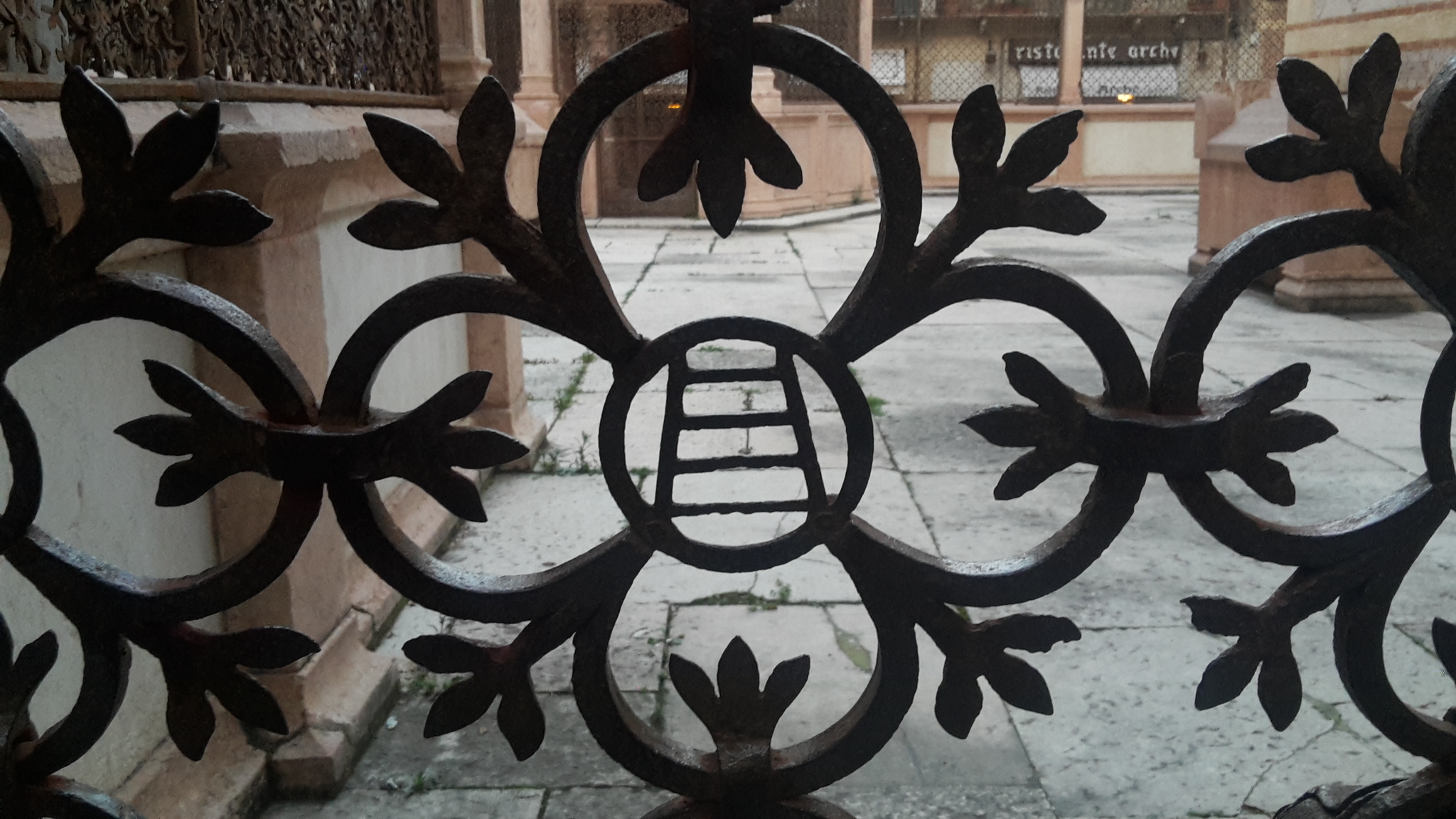
All'interno della recinzione è infatti posta per l'eternità, tutta intera, la discendenza scaligera, “la prole diva/de la Scala joiliva”, ovvero “la stirpe divina della Scala gioiosa”: i grandi e i meno grandi, i buoni e i cattivi, nei sarcofaghi a terra e nelle spettacolose e fantastiche tombe aeree; tutti dentro, meno uno, il più grande, il più valoroso... Cangrande I.
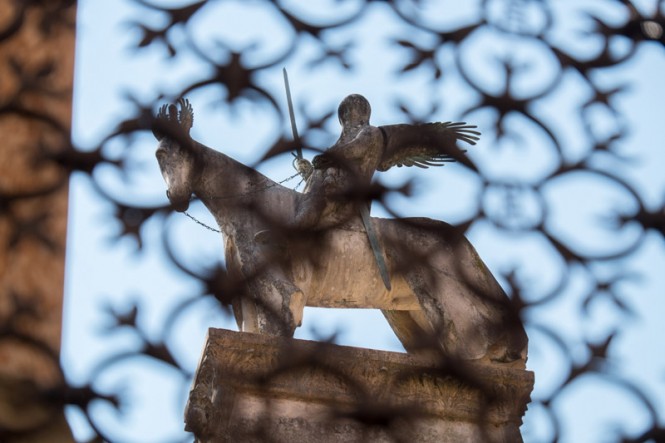
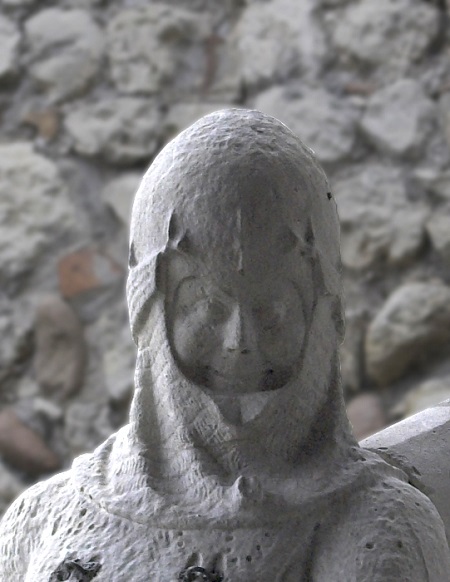
Per giustificare questo singolare sorriso di Cangrande, tra l'altro è raffigurato sorridente anche lui come l'altro grande “Signore” di Verona San Zeno (GC865D9), non vi dico che cosa non sono andati a tirar fuori i critici d'arte: modelli antichi, statue tedesche, francesi... e si continua a discuterne perché in realtà questa scultura è la sola nel suo genere, unico esempio di statua equestre, per di più funebre, con il sorriso, come pure è sorridente la sua effige scolpita sul coperchio del sarcofago; a noi veronesi, più semplicemente, piace pensare ed identificare nell'espressione un po' scanzonata del nostro principe lo spirito della città e della sua gente, sorridente e bonaria, veronesi tuti mati, appunto!
A tutt’oggi l'esponente più conosciuto, celebrato ed amato della dinastia scaligera, Alberto Can Francesco Della Scala, detto Cangrande, nacque a Verona il 9 Marzo 1291; fisicamente prestante e di bella presenza, dimostrò da subito di essere anche molto deciso e risoluto, assoggettando a Verona i territori limitrofi di Vicenza, Treviso, Padova, Mantova e Brescia. Nominato all'età di vent'anni Vicario Imperiale del Sacro Romano Impero, fu leader per molti anni della Lega ghibellina nel Nord d'Italia.
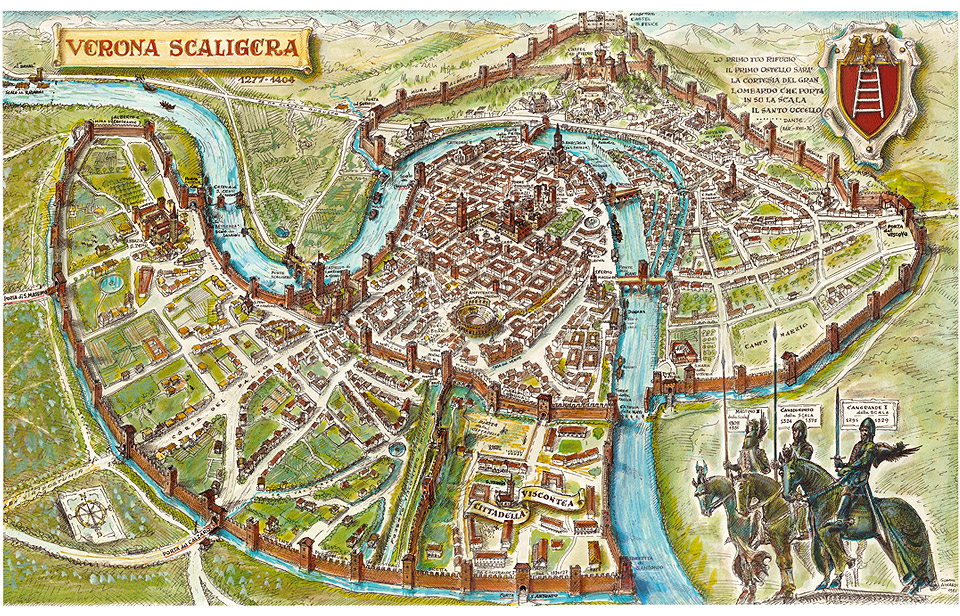

Cangrande non fu solo un abile conquistatore, ma anche uno scaltro politico ed un accorto amministratore; Verona visse con lui un periodo particolarmente florido, di pace e prosperità. Il popolo veronese ed anche quelli delle altre provincie conquistate lo ritenevano un sovrano dotato, capace e giusto, tanto che i cronisti dell’epoca ebbero per lui grandi parole di lode e stima, ritenendolo un sovrano che “non si appagava del proprio guadagno, ma cercava il guadagno del popolo”. Sotto la sua guida prosperarono Verona e tutti i territori della Signoria, senza rivolte o sommosse, salvo alcuni rari e modesti episodi.
Patrono delle arti e dell’apprendimento in generale, Cangrande fu notoriamente anche un generoso mecenate che nella sua reggia accolse scienziati, poeti, pittori ed artisti di gran talento come ad esempio Giotto, ma su tutti Dante Alighieri, per il quale nutrì, ricambiato, una sincera amicizia ed una grande ammirazione, al punto che gli venne dedicata la terza e più importante cantica della Divina Commedia, il Paradiso:
“Lo primo tuo rifugio, il primo ostello sarà la cortesia del gran Lombardo
che’ in su la scala porta il santo uccello, ch’in te avrà sì benigno riguardo che del fare e del chiedere
tra voi due fia primo quel che, tra gli altri è più tardo”.
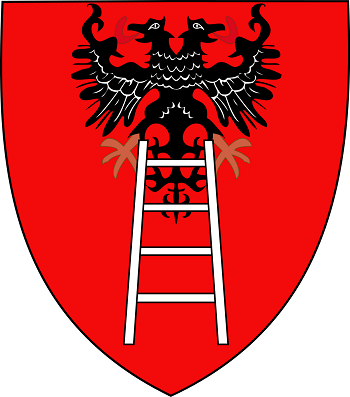
Boccaccio lo inserisce tra i protagonisti del Decamerone, nel settimo racconto della prima giornata, rappresentandolo come un saggio governante, in questo modo:
“Chiarissima fama quasi per tutto il mondo suona,
messer Cane della Scala, al quale in assai cose fu favorevole la fortuna,
fu un de’ più notabili e de’ magnifici signori che dallo ‘mperadore Federico secondo in qua si sapesse in Italia”.
Infine, l’interesse personale di Cangrande per l’eloquenza e il dibattito si riflette dalla sua aggiunta di una cattedra di retorica alle sei cattedre già previste dagli statuti veronesi dell’epoca.
Il 22 Luglio 1329, a soli 38 anni, Alberto Can Francesco Della Scala morì al termine del vittorioso assedio di Treviso, c'è chi sostiene avvelenato intenzionalmente, altri invece accidentalmente per un sovradosaggio nel tentativo di curare una malattia polmonare cronica.
Come già detto la sua tomba è posta esternamente al recinto delle Arche Scaligere, sopra l'ingresso laterale dell'adiacente chiesetta romanica di Santa Maria Antica, nell'arca adorna di preziose sculture illustranti le sue vittorie sulla porta, con su un altissimo baldacchino a piramide che regge una copia della famosa statua a cavallo, il cui originale è ospitata e custodita al Museo di Castelvecchio.

La cache
ATTENZIONE
Questa è una Multi e pertanto la cache fisica non si trova alle coordinate iniziali, ma al termine di un itinerario lungo 1,5 km ca.
Non pubblicare immagini spoiler di GZ final né del camuffamento che va maneggiato e riposizionato con cura!
Log privi di firma sul logbook saranno cancellati senza alcun ulteriore avviso!
Poiché GZ final è zona ad intensa presenza/passaggio di babbani, si raccomanda cautela.
Stage 1 - Come dicevo all’inizio ci troviamo alle Arche Scaligere ed in prossimità dell’ingresso si trova una tabella didattica che nel titolo riporta una cifra in numeri romani, da “tradurre” in numerazione corrente... = A
Stage 2 - Recatevi ora nel cosiddetto “Salotto di Verona”, l'aristocratica Piazza dei Signori... al cospetto del Sommo Poeta prendetevi il tempo per ammirare l'armoniosità dei palazzi che la delimitano ed infine individuate il Palazzo di Cangrande, oggi sede della Prefettura; quale numero civico è affisso al suo angolo destro? = B
Stage 3 – Qui vi trovate nella più popolana Piazza Erbe, dove potete ammirare l’edificio medioevale della Domus Mercatorum, voluto dalla Signoria degli Scaligeri come luogo in cui le corporazioni delle arti e dei mestieri potessero incontrarsi per commerciare e discutere i vari aspetti della vita economica della città e della quale venne nominato Podestà anche lo stesso Cangrande; detto questo, serve conoscere:
1. Il numero preciso delle pigne che adornano la scalinata in marmo di accesso al piano superiore. = C
2. Il numero degli archi che compongono il porticato al piano strada, sui quattro lati esterni. = F
Stage 4 – Vi trovate all’incrocio tra Piazzetta Scala, Via Scala e Vicolo Scala… la chiesa è quella di Santa Maria Della Scala, ovviamente, costruita su un terreno donato da Cangrande ai Servi di Santa Maria nel 1324; escludendo la parte superiore col timpano ad arco, quante formelle di forma quadrata decorano il solo portone d’ingresso? = G
Stage 5 - Siete arrivati a Castelvecchio che, fatto erigere da Cangrande II tra il 1354 ed il 1357, non ospitò quindi mai Cangrande I, ma dal suo cortile interno è possibile ammirare l’originale della statua che ne ornava l’arca sepolcrale e, se lo vorrete, visitare il museo; passato il ponte levatoio, appesa al soffitto della porta d’ingresso vi è una lanterna che riporta un numero di tre cifre… = D
Orari di apertura: Lunedì 13:30-19:30, Martedì-Domenica 8:30-19:30
Stage 6 – Ultimo indizio prima della final; anche qui una lanterna appesa al soffitto riporta un numero, ma questa volta di una sola cifra… = E
Ci siamo quasi, manca solo qualche calcolo ed ancora pochi passi perché la final fisica si trova alle coordinate:
N 45° (B x 2)(E + 1).(D – G – 149)
E 010° E(C x 2).(A + 8)(F : 2)
Buon Geocaching!


W or "Veronesi and Veronesità", a series of caches dedicated to characters, places and traditions more or less known that aims to make them known or rediscover through a "Geo-route" which, I still do not know where it will take me/us, but wants to be a declaration of Love for Verona, my city, its territory and the people who, each in their own way, have "celebrated" it with their own life even before their deeds, small or great that they are.
I Love my city that I feel mine and of the people who have lived there forever, since yesterday or today, or who will come tomorrow even if only to visit it for a day; I love it because it is beautiful, full of monuments of all ages, of many stories and countless events and being veronese, not just by birth, contains all this and much more ... veronesi tuti mati!
W1 - Cangrande I Della Scala
Arrived at the initial coordinates, while all around rise houses, palaces and churches belonging to the Lordsghip Scaligera, here in front, behind a wall surmounted by a stupendous and, at least for the veronesi, famous wrought iron gate with the beloved coat of arms, the Della Scala tomb is located; we are in fact at the Arche Scaligere, one of the most characteristic monuments of Verona which, with fantastic pinnacles, spiers, columns, cusps and marble statues, represents absolutely one of the highest and at the same time singular expressions of Gothic architecture and sculpture in Italy.
In fact, within the enclosure is the whole of the Scaliger lineage, "the offspring of the Ladder joiliva", or "the divine lineage of the joyful Ladder": the great and the less great, the good and the bad, in the sarcophagi on the ground and in the spectacular and fantastic aerial tombs; all inside, minus one, the greatest, the most valiant... Cangrande I.
To justify this singular smile of Cangrande, among other things he is also smiling as the other great "Lord" of Verona St. Zeno (GC865D9), I do not tell you what jams made the critics of art: ancient models, German statues and French ones... and they continue to discuss it because in reality this sculpture is the only one of its kind, the only example of an equestrian statue, moreover funereal, with a smile, as well as smiling is his effigy carved on the lid of the sarcophagus; to us people of Verona, more simply, like to think and identify in the expression a little light-hearted of our prince, the spirit of the city and its people, smiling and good-natured, "veronesi tuti mati" that means “veronesi all crazy”!
Nowadays the most famous exponent, celebrated and loved by the Scaliger dynasty, Alberto Can Francesco Della Scala, called Cangrande, was born in Verona on March 9th 1291; physically lending and with a beautiful presence, he immediately proved to be very determined and resolute, subjecting the neighboring territories of Vicenza, Treviso, Padua, Mantua and Brescia to Verona. Nominated at the age of twenty years Imperial Vicar of the Holy Roman Empire, he was leader for many years of the Ghibelline League in the North of Italy.
Cangrande was not only an able conqueror, but also a shrewd politician and a prudent administrator; Verona lived with him a particularly prosperous period of peace and prosperity. The people of Verona and also those of the other conquered provinces considered him a sovereign gifted, capable and just, so that the chroniclers of that time had great words of praise and esteem for him, considering him a sovereign who "did not satisfy his own gain, but he sought the gain of the people". Under his guidance prospered Verona and all the territories of the Lordship, without riots, except for some rare and modest episodes.
Patron of the arts and learning in general, Cangrande was notoriously also a generous patron who in his palace welcomed scientists, poets, painters and artists of great talent such as Giotto, but above all Dante Alighieri, for whom he fed, reciprocated, a sincere friendship and a great admiration, to such an extent that he was dedicated to the third and most important canticle of the Divine Comedy, Paradise:
"Your first refuge, the first hostel will be the courtesy of the great Lombard
that 'up the ladder brings the holy bird, which in you will have so benign regard that of doing and asking
between you two first the one which, among others, is later ".
Boccaccio places him among the protagonists of the Decameron, in the seventh story of the first day, representing him as a wise ruler, in this way:
"Very clear fame almost for the whole world sounds,
Messer Cane della Scala, to whom fortune was most favorable,
he was one of the most notable and of the magnificent lords who since the 'mperor Frederick second were known in Italy ".
Finally, Cangrande's personal interest in eloquence and debate is reflected in his addition of a chair of rhetoric to the six professorships already provided for by the Verona statutes of the time.
On July 22, 1329, at only 38 years old, Alberto Can Francesco Della Scala died at the end of the victorious siege of Treviso, there are those who intentionally poisoned, others accidentally overdose in an attempt to treat a chronic lung disease.
As already mentioned, his tomb is located outside the enclosure of the Arche Scaligere, above the side entrance of the adjacent Romanesque church of Santa Maria Antica, in the ark adorned with precious sculptures illustrating his victories on the door, with a very high canopy pyramid holding a copy of the famous horse statue, whose original is housed and kept in the Castelvecchio Museum.
The cache
WARNINGS
This is a Multi and therefore the physical cache is not at the initial coordinates, but at the end of a 1.5 km long route.
Do not post spoiler images of GZ final nor camouflage that must be handled and repositioned with care!
Logs without signature on the logbook will be deleted without any further notice!
Since GZ final is an area with an intense presence/passage of Muggles, caution is recommended.
Stage 1 - As I said at the beginning we are at the Arche Scaligere and near the entrance there is a didactic table that in the title shows a number in Roman numerals, to be "translated" into current numbering... = A
Stage 2 - Go now to the so-called "Lounge of Verona", the aristocratic Piazza dei Signori... in the presence of the Supreme Poet, take the time to admire the harmony of the palaces that surround it and finally identify the Palace of Cangrande, now the seat of the Prefecture; what house number is affixed to its right corner? = B
Stage 3 - Now you find yourself in the most populate Piazza Erbe, where you can admire the medieval building of the Domus Mercatorum, wanted by the Lordship Scaligera as a place where the guilds of arts and crafts could meet to trade and discuss the various aspects of the economic life of the city and of which Cangrande himself was also appointed Podestà; having said this, you need to know:
1. The precise number of pine cones that adorn the marble staircase leading to the upper floor. = C
2. The number of arches that make up the portico on the street level, on the four external sides. = F
Stage 4 - You have reached the intersection of Piazzetta Scala, Via Scala and Vicolo Scala... the church is that of Santa Maria Della Scala, obviously, built on land donated by Cangrande to the Servants of St. Mary in 1324; excluding the upper part with the arched tympanum, how many square-shaped tiles decorate the entrance door only? = G
Stage 5 - Here you arrived in Castelvecchio that, built by Cangrande II between 1354 and 1357, therefore never hosted Cangrande I, but from its inner courtyard it is possible to admire the original of the statue that adorned the sepulchral ark and, if you wish, visit the museum; past the drawbridge, hanging from the ceiling of the main gate there's a lantern bearing a number of three digits... = D
Opening time: Monday 1.30pm-7.30pm, Tuesday-Sunday 8:30am-7:30pm
Stage 6- Last indication before the final coordinates; also here a lantern hanging from the ceiling shows a number, but this time of a single digit... = E
We are almost there, only a few calculations are missing and still a few steps because the physical final is at the coordinates:
N 45° (B x 2) (E + 1). (D - G - 149)
E 010° E (C x 2). (A + 8) (F: 2)
Happy hunting!

